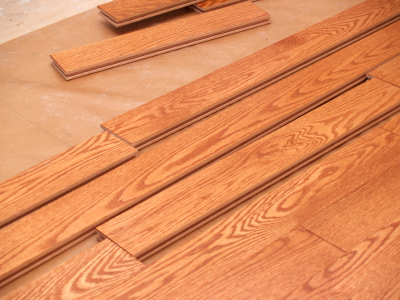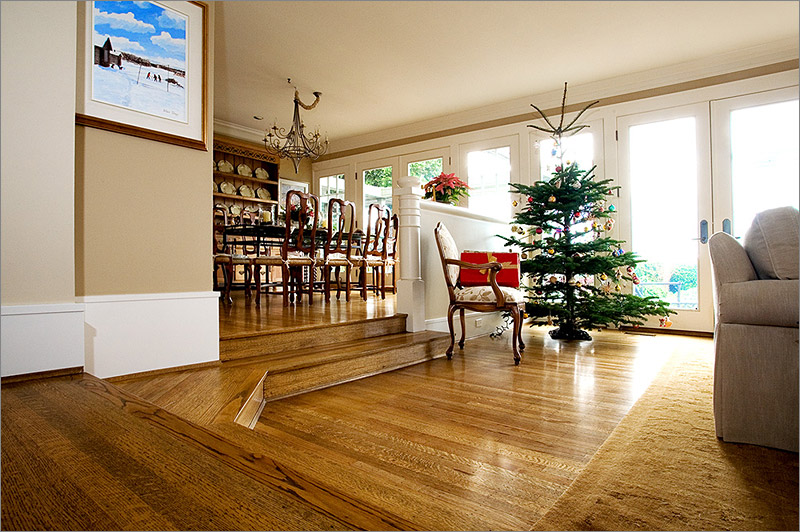How to Choose Hardwood Flooring
Choosing the variety of hardwood flooring board that you’ll be happiest with can go beyond the simple choice of color; you have more options open to you than you think! Find out a little bit more about the variety of hardwood that may best suit your hardwood flooring board ideal.
Now that you have decided that the structural strength, the old-world dependability and permanence of hardwood flooring board is the right choice for your space, you now have another level of choices available to you. Having options means enjoying a greater flexibility as far as the direction in which you want to go, but sometimes it can be a bit confusing too. For hardwood flooring board, there are several varieties from which to choose, and all of them have advantages as far as look and practicality are concerned. Here are some brief profiles of some excellent options you might consider when it comes to hardwood flooring board species.
White Oak
This sturdy hardwood was a mainstay for shipwrights in the age of the tall ship, being very resistant to moisture as well as being very easy to work with in terms of cutting and fastening. The use of white oak was common to the eastern United States, as well as in the Midwestern Great Lakes region, where many ocean going ships were constructed with this species of hardwood. White oak makes excellent hardwood flooring board because of its strength and general durability. The white oak wood itself is as descriptively light in color, with subtle touches of brown highlighting it.
Red Oak
Red oak was the workhorse hardwood of the Industrial Age, used not only as hardwood flooring board and for furniture, but also for use in making railroad ties and wagon wheels. This diverse usage is due in part to the wide availability of red oak hardwood, but also because of its hardness and adaptability to all kinds of household and commercial uses. Red oak is very easy to stain and yields a very good finish. Much like the white oak, it is very resistant to wear, making it a very practical choice for hardwood flooring board. Red oak wood is very attractive, demonstrating a pinkish hue in addition to its tonal range of off-whites and light browns.
American Cherry
American Cherry is also known for its abundance as a hardwood species in North America, and its reputation a hardwood flooring board precedes it in many ways. Known for its rich natural deep burgundy exterior, cherry is a popular choice for use as hardwood flooring board, but also in cabinet making, paneling, and many other practical uses where reliable materials that are meant to last. American Cherry hardwood is one of the softer hardwoods and while not recommended as flooring board for high traffic areas, its reputation as easy to work with is renowned. Cherry hardwood is an ornate yet dependable choice for your hardwood flooring board project, with a range of color that spans off-white to reddish tones, making it truly distinctive. Because of its photosensitive nature, cherry will darken with age over time.
Hard Maple
Sometimes known as Canadian maple, or sugar maple, hard maple is a hardwood upon which Native Americans and early North American settlers depended heavily. Not only important for shelter, hard maple was used for making anything from footwear to weaponry, and from soap to syrup. The hardest of all maples, hard maple is known for its strength as well as its very abrasion- and wear-resistant surface. It also has a fine, uniform texture. These traits make maple a great choice for hardwood flooring board. Maple hardwood flooring board is often available in a pre-stained form. This variety of hardwood is the lightest of all species of maple and is characterized by a range of light to darker shades of rich brown, often with reddish highlights.
White Ash
Another popular variety of hardwood flooring board is white ash. It is characterized by the density and strength of the wood itself, making it a logical choice for its use as hardwood flooring board. Among other things, white ash is a popular wood out of which baseball bats and other types of athletic equipment designed for maximum stress are made. You can be assured that white ash hardwood flooring board can stand up to heavy foot traffic! The color of the wood ranges from a blonde cream to light brown with amber highlights, a lighter range than white oak. The grain pattern in white ash is similar to that of red oak, but without some of oak’s pinkish tones.
Yellow Birch
Yellow birch has been long considered a reliable hardwood lumber because of its ease of use from the standpoint of builders and manufacturers. Historically, birch’s bark was famous for making canoes, and subsequently used for centuries in making all types of household items as well as enhancing interiors in many ways, including its use as hardwood flooring board. The yellow birch tends to be slightly more golden in color when compared to other species of birch, although it retains creamy white highlights. Yellow birch hardwood often features curling patterns in the grain that make it stand out among hardwoods. The wood is characterized by a fine, uniform texture, making it perfect for attractive hardwood flooring board.
Black Walnut
Walnut stands as a decorative hardwood which is widely used through out the world. A hardwood known for its close-grain appearance and dark luster when used as hardwood flooring board, black walnut is another product in flooring that is widely available in North America. Although not as hard as some hardwood species and not recommended as flooring in high traffic areas, black walnut hardwood flooring board is very accommodating in terms of its ease of use from an installer’s point of view, and as a building material in general. Black walnut cuts, nails, and takes to glue very well, and it accepts stains very easily. The wood of the walnut varies in color from light to deeper golden brown tones, and on to even darker, chocolaty hues, with grains equally varied from straight to wavy patterns.
Brazilian Cherry, aka Jatoba
This richly colored hardwood is known both as Brazilian Cherry and as Jatoba. Although it is not technically a cherry wood, it is like cherry in certain respects, and quite unlike in others. Brazilian Cherry is extremely versatile and is used in cabinet making, tool handles, and athletic equipment. It also makes excellent hardwood flooring board. The coloring of this exotic hardwood is very distinctive, characterized by a lustrous range of deep reds, burgundies, and darker reddish browns, making it an extremely decorative hardwood flooring board option with an exotic, high-end appeal. This hardwood flooring board is photosensitive and will darken over time, just like American cherry hardwood. The wood is extremely dense and hard, more so than many domestic hardwoods, which makes it a very reliable choice for hardwood flooring board.
Choosing the variety of hardwood flooring board which is best suited to your home or commercial project adds an additional level of ownership which can be enjoyed well into the future, knowing that the choice you’ve made reflects not only practicality and beauty, but also personality. After all, the hardwood flooring board you choose will define the living area or working area for a long time to come.




Greg
I wish to install a wood floor for my 3rd floor condo kitchen. Because of the possibility of liquid spills, is it advisable to glue along seams and joints? What underlayment is recommended?
Additionally, I would love to redo the entire apartment with wood/laminate flooring but HOA rules prohibit this due to noise considerations. In the decades since those rules were written, what has been done to help soundproof wood/laminate flooring? Is there a chart available that compares carpet vs. wood? I’ve lived on first floors beneath carpeted units, and I can not tell any difference in sound reduction. Kids are noisy at all levels. Anything you can provide to help me make my argument to the HOA in favor of wood with soundproofing would help.
Thanks,
Greg
Bea Coffino
I was told that hardwood is not suggested for areas that are moist. I live in southern Florida and as you know it is very humid here a good part of the year. Am I better off with the porcelain look alike? I would want to do my whole apartment , approx 880 sq ft.
BuildDirect Product Expert Team
Hi Bea,
Thank you for getting in touch! Yes, tile would be a much better option for you. Any natural wood product, like hardwood; engineered hardwood or laminate, is susceptible to expansion and contraction based on the change in humidity and temperature in the area. Also, these products are not moisture resistant so high humidity could cause water damage. Another option that could work would be luxury vinyl plank flooring. These are water resistant and can be a bit sifter under foot than tile. Please let us know if you have any other questions!
Richard
What is a good choice of hardwood for high traffic areas and dogs? I have a double level condo. I was told by a designer that Brazilian Cherry was a good choice however I wanted something with a more even tone.
Thanks
Richard
BuildDirect Product Expert Team
Hi Richard,
Thank you for getting in touch! Brazilian Cherry, Cumaru, Ipe or Hickory would be good options for you because they are extremely durable. Most of these options will have some color variation but if you choose a stained product over a natural, pre-finished option you will have less variation. I definitely suggest taking a look through some options on our website and getting some samples to compare colors and durability. Please let us know if there is anything else we can help out with!
Renu
Which is a better wood for hardwood flooring,reliable,I heard Brazilian jato a is not good but I like the look of it.any suggestions on it,my second choice is maple,which is better canadian maple or one which comes from china, also how can you know if it is canadian maple or from china.
Chicagoland Pro
There are many factors to consider when selecting a wood, including color, grain, durability and versatility. Different types of wood can give your home a unique, new look. Some types of wood take color easily, while others look best with a natural finish. Woods like oak and maple are durable, and resist dents well. The most common wood used on floors is 3/4″ x 2 1/4″ red oak, because oak takes various types of stain the best. As professional hardwood installers, we help our clients choose the best fit for their needs.